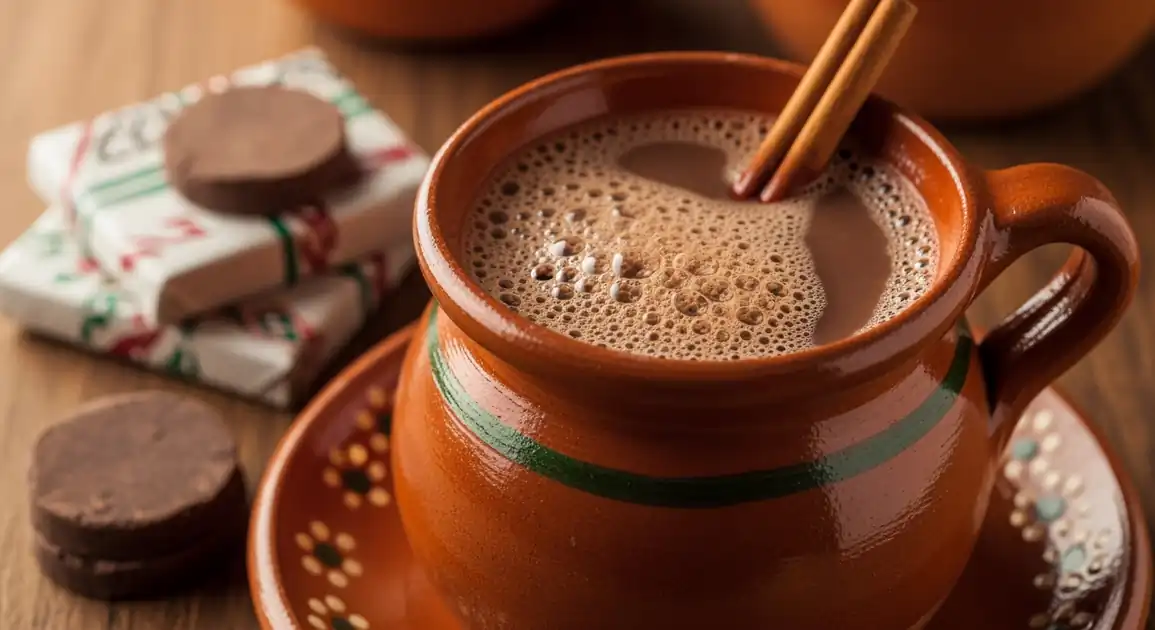Chocolate de Agua
Chocolate de Agua

Description
Oaxaca is considered the heart of Mexican chocolate tradition, with Chocolate de Agua representing an essential cultural element. The city and surrounding valleys are home to numerous chocolateros (chocolate makers) who maintain traditional stone-grinding techniques. Oaxacan Chocolate de Agua is distinguished by its complex flavor profile that often includes almonds, cinnamon, and sometimes vanilla or other regional ingredients.
Dietary Information
Serving information
Serving style
In Oaxaca, traditionally served in locally-made clay mugs that help maintain temperature and are believed to enhance flavor. Often accompanied by pan de yema (egg bread) or other local breads for dipping.
Quick facts
Markets: 7 AM - 3 PM. Cafés and specialty shops: 8 AM - 8 PM. Some establishments in tourist areas may open later and close later.
Safety Tips
What to Look For
-
Freshly prepared to order
The best Chocolate de Agua is prepared fresh for each customer. Look for vendors actively preparing drinks rather than keeping large batches sitting out.
-
Very hot temperature when served
Properly prepared Chocolate de Agua should be served very hot, which helps ensure any potential pathogens have been eliminated through boiling.
-
Clean preparation area and equipment
Observe the cleanliness of molinillos, serving vessels, and the general preparation area.
-
Agua purificada (purified water) usage
Quality vendors, especially those catering to tourists, will use purified water. It's acceptable to ask if they use 'agua purificada' for preparation.
-
Proper froth on top
Well-prepared Chocolate de Agua should have a light froth layer on top, indicating proper preparation with a molinillo.
What to avoid
-
Lukewarm temperature
Avoid if served at room temperature or barely warm, as this could indicate it's been sitting out for too long.
-
Premixed large batches sitting for hours
This increases the risk of bacterial growth, especially in warmer weather. Prefer vendors who prepare small batches or individual servings.
-
Dirty or rusty preparation equipment
While traditional equipment may look worn, it should still be clean and well-maintained.
-
Unusual smell or visible contaminants
Fresh Chocolate de Agua should smell pleasantly of chocolate and spices. Any off odors or visible impurities are warning signs.
-
Floating film or separation
Properly prepared Chocolate de Agua should be well-mixed without separation of fats or unusual films on the surface.
Price information
Price range
Budget tips
- Traditional markets like Central de Abastos or 20 de Noviembre offer the best value (25-40 MXN).
- Family-run cafés typically charge mid-range prices (40-60 MXN).
- Tourist-oriented establishments in the historic center charge premium prices (60-90 MXN).
- Many traditional breakfast spots include Chocolate de Agua as part of meal combinations.
Value indicators
- Visibly prepared with local chocolate tablets rather than commercial mixes.
- Proper frothing technique with a molinillo.
- Served in traditional clay vessels.
- Balanced flavor with clearly detectable cinnamon and chocolate notes.
- Proper temperature - very hot but not scalding.
Where to Find This Dish
Historic Center (Centro Histórico)
Numerous cafés and chocolate shops surrounding the Zócalo and surrounding streets.
Zócalo, Mercado Benito Juárez, Mina Street
Morning, Afternoon
20 de Noviembre Market
Food section of this popular market includes several vendors specializing in traditional beverages.
Mercado 20 de Noviembre food hall
Morning, Mid-day
Reforma
This neighborhood has several traditional chocolaterías.
Parque El Llano
Morning
Jalatlaco
This historic neighborhood has charming cafés serving traditional chocolate.
Templo de San Matías Jalatlaco
Morning, Afternoon
Vendor Tips
- Look for places grinding their own chocolate or clearly displaying which local producer they source from.
- Some vendors offer tastings of different chocolate tablets before preparing your drink.
- Ask about the 'altura' (elevation) where the cacao was grown - some vendors specifically highlight chocolate from certain regions.
- Many chocolate shops offer both ready-to-drink beverages and chocolate tablets to prepare at home.
How to Order
Regional Variations
-
Chocolate de Agua Tradicional Oaxaqueño
(Chocolate de Agua Tradicional Oaxaqueño)
The most authentic version using stone-ground chocolate with cinnamon and sometimes almonds, meticulously frothed with a molinillo.
-
Chocolate para Mesa
(Chocolate para Mesa)
A slightly thicker version specifically designed for dipping bread, with a higher ratio of chocolate to water.
-
Chocolate con Nuez
(Chocolate con Nuez)
A regional variation that incorporates local nuts beyond just almonds.
-
Chocolate de Tascalate
(Chocolate de Tascalate)
Found in some traditional establishments, this reddish variation incorporates achiote (annatto) and sometimes maize, reflecting indigenous traditions.
Cultural context
History
Chocolate de Agua dates back to pre-Hispanic Mesoamerica, where indigenous peoples consumed cacao-based drinks long before European contact. The Aztecs and Mayans valued cacao as a sacred substance and prepared it with water, often unsweetened and sometimes spiced with chili. Following Spanish colonization, Europeans added sugar and eventually milk, but the water-based version remained important, especially in regions like Oaxaca where indigenous traditions persisted. Today, Chocolate de Agua represents the closest connection to ancient Mesoamerican chocolate consumption practices.
Local significance
In Oaxaca, Chocolate de Agua represents both cultural heritage and everyday tradition. The region's reputation for exceptional chocolate makes this drink a source of local pride and identity.
Eating customs
- In Oaxaca, traditionally enjoyed with pan de yema or other local breads.
- Often the first thing consumed in the morning in traditional households.
- Some locals add a pinch of salt to enhance flavor - an ancient practice.
- Traditional clay cups are preferred as they're believed to impart subtle earthy notes.